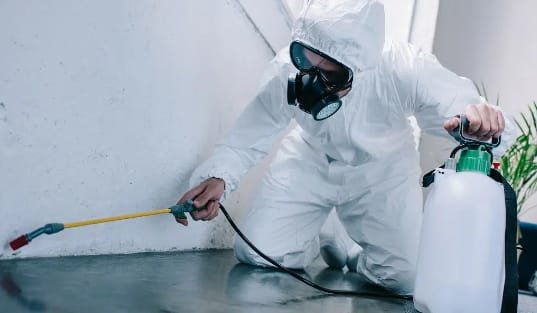Business
How Does Professional Pest Control Work?
Published
1 year agoon
By
Ali Ahmed
Pests are unwelcome guests in our homes and workplaces, sometimes causing major issues for the property and its people. Pests may be a major nuisance and health risk, causing damage to structures and belongings as well as the spread of illnesses. Professional pest control London services offer a reliable and long-term solution to these issues. This article will look at how professional pest control works, from detecting the issue to providing a tailored treatment and ensuring pests do not return.
Understanding the Pest Problem
The first stage in professional pest management is to identify the nature and scope of the pest infestation. Commercial pest control London, often known as exterminators, are educated to recognise various pests and their habits. This information is critical for establishing a focused and realistic pest elimination strategy. Here are the important steps in understanding the pest problem:
1. Inspection
Professional pest control starts with a comprehensive inspection of the premises. Technicians will examine for indicators of pest activity, such as droppings, gnaw marks, nests, and damage. They will also look for potential entrance points, such as fractures in walls, gaps in windows and doors, and screen holes. This examination allows the specialist to assess the kind of pest infestation and its severity.
2. Identification
After the inspection, the technician identifies the specific type of pest causing the problem. This is essential because different pests require different control methods. For example, the methods used to eliminate termites differ from those used for rodents or insects. Proper identification ensures the treatment plan is effective and minimises harm to non-target species.
3. Assessment
Once the pests are identified, the technician assesses the extent of the infestation. This involves determining the size of the pest population, the areas they affect, and the potential risks they pose to the property and its occupants. This assessment helps develop a customised treatment plan that addresses the situation’s specific needs.
Developing a Treatment Plan
After determining the pest problem, the following stage is to devise a treatment plan. This strategy is customised to meet the individual demands of the property and the kind of pest infestation. It entails selecting the appropriate procedures and resources to successfully eradicate pests while reducing dangers to humans, pets, and the environment. Here are the key components of a therapy plan:
Selection of Control Methods
Professional pest control professionals employ a number of pest-management procedures. These methods can be generally divided into chemical and non-chemical procedures. The type of pest, the degree of the infestation, and the preferences of the property owner all influence the treatment measures chosen.
a. Chemical Control:
Chemical control entails applying insecticides to eradicate pests. Pesticides can be administered in a variety of ways, including sprays, baits, and dusts. The type of pesticide used and the technique of application are determined by the pest and the area of the infestation. For example, liquid sprays can cure termites in the soil, but bait stations successfully manage rodents.
b. Non-Chemical Control:
Non-chemical control methods reduce the reliance on pesticides and provide a more environmentally friendly approach. These methods include physical barriers, traps, and biological controls. For example, sealing cracks and crevices can prevent pests from entering the property, while traps can be used to capture and remove rodents. Biological controls involve using natural predators or parasites to control pest populations.
Integrated Pest Management (IPM)
Many professional pest control companies use Integrated Pest Management (IPM). IPM is a comprehensive strategy that combines multiple control methods to manage pests effectively and sustainably. The fundamental principles of IPM include:
- Prevention: The first line of defence is preventing pests from entering the property. This involves identifying and eliminating potential entry points and making the environment less attractive to pests.
- Monitoring: Regular monitoring helps detect pest activity early and allows for timely intervention, reducing the need for large-scale pesticide applications.
- Thresholds: IPM sets thresholds for acceptable pest levels. Control measures are only applied when these thresholds are exceeded, minimising the use of pesticides.
- Control Methods: IPM uses a combination of control methods, including chemical and non-chemical approaches, to manage pests effectively.
- Evaluation: The effectiveness of the control measures is regularly evaluated, and adjustments are made as needed to ensure long-term success.
Implementing the Treatment Plan
Once the treatment plan is developed, the next step is to implement it. This involves applying the chosen control methods and materials to eliminate the pests. Professional pest control technicians are trained to apply these methods safely and effectively. Here are the critical steps involved in implementing the treatment plan:
1. Preparation
Before the treatment begins, the technician will provide instructions on how to prepare the property. This may include clearing the area of clutter, covering or removing food items, and relocating pets and people to a safe area. Proper preparation ensures the treatment is effective and minimises risks to occupants.
2. Application of Control Methods
The technician will then apply the chosen control methods. This may involve spraying pesticides, setting traps, or installing physical barriers. The application is targeted to ensure maximum effectiveness while minimising exposure to non-target species. For example, bait stations may be placed where rodents are active, while pesticides are applied to cracks and crevices where insects hide.
3. Follow-Up Treatments
In some cases, follow-up treatments may be necessary to ensure complete elimination of the pests. This is especially true for severe infestations or pests with long life cycles, such as termites. The technician will schedule these follow-up treatments as needed and monitor the progress of the control measures.
Ensuring Long-Term Pest Control
Professional pest control services focus on eliminating the current pest problem and preventing future infestations. This is achieved through regular monitoring, preventive measures, and customer education. Here are the critical components of ensuring long-term pest control:
1. Regular Monitoring
Regular monitoring is required to discover symptoms of pest activity early and take appropriate action. Professional pest control firms frequently provide maintenance packages that involve periodic inspections and treatments. These measures serve to keep pests at bay and prevent small issues from escalating into larger infestations.
2. Preventive Measures
Preventive measures are an important part of long-term pest control. These include sealing cracks and crevices, installing screens on windows and doors, and keeping the property clean and clutter-free. By making the environment less attractive to pests, property owners can reduce the likelihood of future infestations.
3. Customer Education
Professional pest control professionals also teach property owners how to prevent pests. This contains recommendations for cleanliness, trash management, and landscaping methods. Educating clients about the importance of pest prevention enables them to take proactive measures to safeguard their property.
Safety and Environmental Considerations
Safety and environmental considerations are essential aspects of professional pest control. Technicians are trained to use pesticides and other control methods safely and responsibly. Here are the critical safety and environmental considerations:
1. Safe Use of Pesticides
Professional pest control professionals are trained to use insecticides safely. They employ the proper personal protective equipment (PPE) and adhere to label directions to ensure safe and effective use. This reduces the likelihood of exposure to occupants and non-target animals.
2. Minimising Environmental Impact
Pest control firms are devoted to reducing the environmental effect of their services. This involves utilising ecologically friendly goods and procedures, such as low-risk insecticides and non-chemical control strategies. Pest control firms that use sustainable procedures may safeguard the environment while efficiently managing pests.
Choosing a Professional Pest Control Service
When choosing a professional pest control service, it’s essential to consider several factors. Here are some tips to help you choose the exemplary service for your needs:
1. Experience and Expertise
Choose a pest control firm that has experience and competence dealing with your particular pest problem. Experienced technicians are better able to detect the problem and establish an appropriate treatment strategy.
2. Licensing and Certification
Ensure that the pest control firm is licensed and qualified to work in your region. This guarantees that they satisfy regulatory requirements and have received the necessary training to offer safe and effective services.
3. Reputation and Reviews
Check the pest control company’s credibility by reading online reviews and requesting references. A corporation with a positive reputation is more likely to deliver excellent service and client satisfaction.
4. Guarantees and Warranties
Choose a pest control business that provides guarantees or warranties for its services. This gives you peace of mind and assures you’re covered if the insect problem persists.
Conclusion
Professional pest control is a comprehensive and effective solution to pest problems. It can eliminate pests and prevent future infestations by understanding the pest problem, developing a targeted treatment plan, and implementing preventive measures. When choosing a pest control service, consider factors such as experience, expertise, and reputation to ensure you receive the best possible service. You can safeguard your property and keep your family safe and healthy by taking the necessary pest control steps.
You may like


Who Is Yasmin Abdallah? Rufus Sewell’s Ex-Wife Turned Style Icon

Who Is Valery Lameignère? The Quiet Life of Molly Ringwald’s First Husband

Rehab Program for Recovery: What to Expect and How It Helps

Who Is Mark Fluent? The Quiet Power Behind Justine Bateman’s Success

Why UK Businesses Are Moving from Traditional Software to AI-Driven Products

Who Is Amanda Kate Lambert? A Look at Her Life, Art, and Family

Fitted Kitchens Nottingham – Bespoke Design and Installation by CID Limited

On Cloud Shoes: Swiss Premium Footwear for Performance, Comfort and Everyday Use in Mexico

Job Security in an Uncertain Economy: Why Caregiving Careers Remain Stable

The Rise of Minimalism in Luxury Kitchen Design

Revolutionizing Healthcare: The Emergence of AI-Driven Analytics

Carol Kirkwood’s Journey: Her Real Age, Husband, Career, and More

How Machine Learning and AI are Redefining the Future?

Aliza Barber: Meet Lance Barber’s Wife, Age, Life, Profile, Career and Net Worth

Evelyn Melendez: Jordan Knight’s Wife Bio, Marriage, Family, Career and Net Worth

Ilan Tobianah Biography: Family, Marriage, Lifestyle, Career and Net Worth

King Von’s Autopsy Report: The Truth Behind the Tragic Death

Body Positivity and Bodycon: Embrace Your Shape with Homecoming Dresses

Who was Alice Marrow? Everything to Know About Ice-T’s and His Mother

Meet Otelia Cox: The Supportive Wife of Tony Cox – A True Fairy Tale Romance

Who Is Yasmin Abdallah? Rufus Sewell’s Ex-Wife Turned Style Icon

Who Is Valery Lameignère? The Quiet Life of Molly Ringwald’s First Husband

Rehab Program for Recovery: What to Expect and How It Helps

Who Is Mark Fluent? The Quiet Power Behind Justine Bateman’s Success

Why UK Businesses Are Moving from Traditional Software to AI-Driven Products

Who Is Amanda Kate Lambert? A Look at Her Life, Art, and Family

Fitted Kitchens Nottingham – Bespoke Design and Installation by CID Limited

On Cloud Shoes: Swiss Premium Footwear for Performance, Comfort and Everyday Use in Mexico

Job Security in an Uncertain Economy: Why Caregiving Careers Remain Stable

The Rise of Minimalism in Luxury Kitchen Design
Category
Trending
-

 Health2 years ago
Health2 years agoRevolutionizing Healthcare: The Emergence of AI-Driven Analytics
-

 News5 months ago
News5 months agoCarol Kirkwood’s Journey: Her Real Age, Husband, Career, and More
-

 Technology2 years ago
Technology2 years agoHow Machine Learning and AI are Redefining the Future?
-

 Celebrity2 years ago
Celebrity2 years agoAliza Barber: Meet Lance Barber’s Wife, Age, Life, Profile, Career and Net Worth
